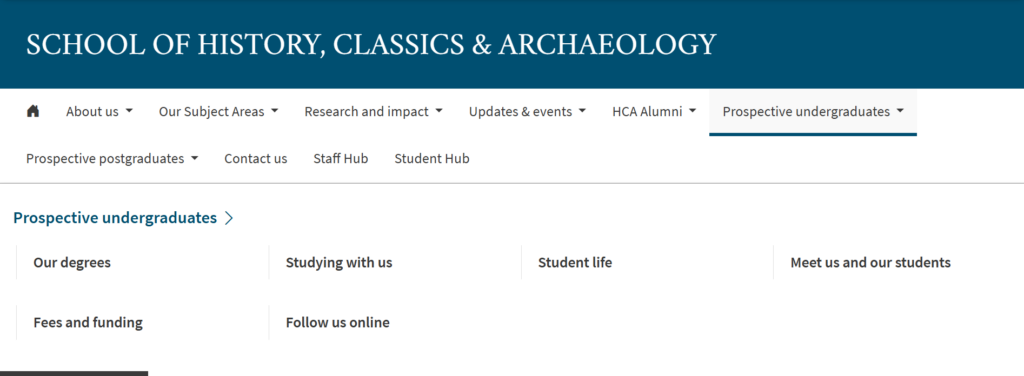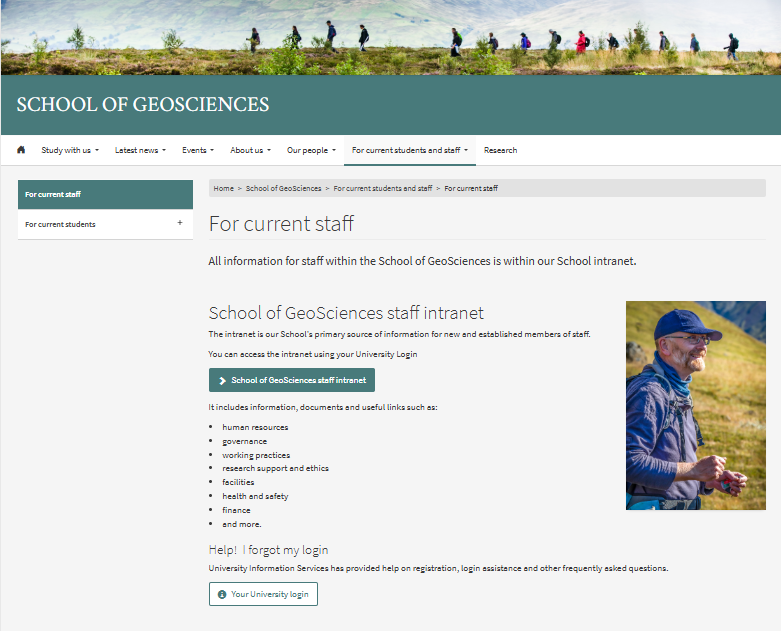Reviewing the EdWeb Migration: A Transformation Beyond Content Transfer
The recent migration from EdWeb has proven to be a monumental task that went far beyond simply moving content from one platform to another. This process, undertaken by lead publishers and technical teams, has provided a pivotal opportunity to fundamentally rethink the core objectives and strategies of the University’s online presence.
A Strategic Overhaul
For many departments and faculties, the migration was not just a technical necessity but a chance to reevaluate and refocus their website’s purposes and target audiences. The transition acted as a catalyst for a broader conversation about how these sites should function and whom they should serve. Instead of a straight swap, we saw strategic enhancements aiming to make websites more than just informative—they are now even more engaging and tailored to meet the specific needs of their primary users.

The main menu of the School of History, Classics, and Archaeology distinctly categorizes options for prospective undergraduate and postgraduate students. It also includes links to external resources for current students and staff.
Selecting the Right Technology
The transition from EdWeb involved a review of various technological solutions. The decision wasn’t just about finding a suitable content management system (CMS) but choosing a technology stack that could support dynamic content delivery tailored to both public and internal audiences. This process ensures that the new system would not only accommodate any School’s current needs but also be scalable for future expansions and integrations.
External-Facing Focus
While a significant number of the websites were already oriented externally, the initiative served as a prompt for some to undertake further reviews. This approach focuses on the strategic refinement of content rather than simply the act of moving websites. This decision reflects a strategic alignment with the university’s goals of enhancing engagement with potential students, alumni, academic peers, and broader public stakeholders. These websites are now designed with intuitive navigation, compelling content, and accessible information, aiming to boost the university’s image and reach on a global scale.
Segregation of Audiences: SharePoint for Internal Use
A crucial aspect of this strategy was segregating content based on the audience, thereby enhancing both accessibility and security. Content specific to staff and matriculated students has been moved to SharePoint, a platform better suited for handling internal communications and sensitive information securely. This clear delineation ensures that all users have straightforward and secure access to the information they need without wading through irrelevant content. To support this change GeoSciences offers guidance on the content available in the newly launched SharePoint Staff-Hub to facilitate user navigation.

Benefits of the Migration
The benefits of this extensive migration project are already becoming evident:
- Opportunity to review the purpose and content of websites: Several lead Publishers embraced the opportunity to review and improve their website-experience
- Streamlined Website Interfaces: Websites now boast cleaner designs and more intuitive structures, significantly improving the user experience.
- Enhanced User Experience: The focused approach on audience-specific content ensures that users find relevant information more quickly and easily.
- Improved Security: By moving internal content to SharePoint, the security of sensitive information has substantially increased, mitigating potential data breaches and unauthorized access.
Looking Forward
The EdWeb Migration illustrated how digital transformations can drive substantial improvements across an organisation. Despite facing challenges, the proactive strategy implemented by several Lead Publishers and their teams to capitalise on this migration as a pivotal opportunity has led to and enhanced web presence for all users.

